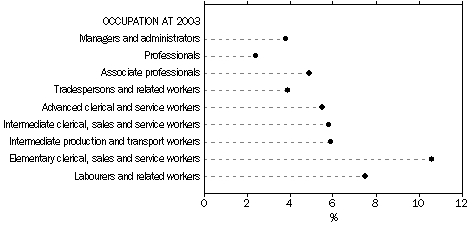ABOUT THIS PUBLICATION
This publication presents information about employment changes of persons aged 15-69 years who had held a job in the 12 months ending February 2004.
ABOUT THIS SURVEY
Statistics in this publication were obtained from the Labour Mobility Survey, conducted throughout Australia in February 2004 as a supplement to the Australian Bureau of Statistics (ABS) monthly Labour Force Survey.
This survey provides information on job mobility and job tenure for persons aged 15-69 years. The survey collected details about jobs held during the 12 months ending February 2004, including whether a job holder changed employer or locality and reasons for change, full-time or part-time status, occupation, industry and duration of job. This information is cross-classified by a range of personal characteristics such as age, sex and educational attainment.
ROUNDING
As estimates have been rounded, discrepancies may occur between sums of the component items and totals.
INQUIRIES
For further information about these and related statistics, contact the National Information and Referral Service on 1300 135 070 or Labour Force and Supplementary Surveys Section on Canberra (02) 6252 7206.
SUMMARY OF FINDINGS
CONCEPTUAL FRAMEWORK
The following diagram illustrates the conceptual framework for the Labour Mobility Survey. Persons aged 15-69 were classified according to whether they were working at February 2004, whether they were working at February 2003 and duration of current job.
OVERVIEW
An estimated 10,159,600 persons aged 15-69 years had worked at some time during the year ending February 2004. Of these persons, 92% were working at February 2004, with the balance either looking for work (3%) or not in the labour force (5%).
Of the 9,360,000 persons working at February 2004:
- 77% had been in their current job for the whole year;
- 14% had been in their current job for less than one year and had worked in a previous job during the year (that is, they had changed jobs during the year); and
- 9% had been in their current job for less than one year and had not had a previous job during the year.
Of the 1,313,300 persons working at February 2004 who had changed jobs during the year:
- 42% (548,000) had changed industry from last to current job; and
- 35% (457,900) had changed occupation from last to current job.
JOB MOBILITY
Of those persons who had worked at some time during the year ending February 2004, 14% (1,455,600) were job mobile (that is, they changed their employer and/or their locality at least once within the previous year). This compares with 15% in 2002, and has remained relatively steady over the last decade.
Of those persons who were job mobile during the year ending February 2004:
- 83% (1,201,700) changed their employer or business;
- 17% (253,900) changed locality while still working for the same employer or business.
Young people were more job mobile than older age groups. For example, of 20-24 year old workers, 22% changed their employer and 2% changed their locality only. This compares with people 45-54 years, of whom 7% changed their employer and 2% changed their locality only.
OCCUPATION
There were 8,485,900 persons who were working at both February 2003 and February 2004. Of those, 85% (7,223,300) had remained in their current job for one year or more, 10% (825,900) had changed their job but not their occupation, and 5% (436,800) had changed both their job and their occupation.
Of all occupations, Elementary clerical, sales and service workers were most likely to have changed occupation (11%) over the previous 12 months, whereas Professionals were least likely (2%).
PERSONS WHO WERE WORKING AT FEBRUARY 2003 AND AT FEBRUARY 2004, Proportion who changed occupation since February 2003

Of the 81,600 Elementary clerical, sales and service workers who changed their occupation between February 2003 and February 2004, 40% (32,600) became Intermediate clerical, sales and service workers, and 13% (10,600) became Labourers and related workers.
FULL-TIME OR PART-TIME STATUS
Of those persons who were working at February 2003 and February 2004, 6,102,800 (72%) were working full time at both points in time. A further 2,116,700 (25%) were working part time at both points in time and 266,400 (3%) had changed their full-time or part-time status.
Of the 266,400 persons who changed their full-time or part-time status, 162,400 (61%) had changed from part-time work at February 2003 to full-time work at February 2004.
DURATION OF CURRENT JOB
Of those persons working at February 2004, 23% had been in their current job for less than one year. The Accommodation, cafes and restaurants industry had the highest proportion (34%) of persons who had worked in their current job for less than one year. In comparison, only 14% of persons employed in the Education industry had worked in their current job for less than one year.
There were 2,202,600 persons who were working at February 2004 and who had been in their current job for 10 years or more. The highest concentrations were recorded in the Agriculture, forestry and fishing industry (47%) and the Electricity, gas and water supply industry (39%). The Accommodation, cafes and restaurants industry (7%) and Retail trade industry (14%) had the lowest proportions of persons who had been in their current job for 10 years or more. A greater proportion of males than females had been in their current job for 10 years or more (26% compared with 20%).
PERSONS WHO CEASED A JOB DURING THE YEAR
Of the 10,159,600 persons who had worked at some time during the year ending February 2004, 2,112,900 (21%) ceased a job during that period.
Of these persons, 1,455,200 (69%) were job leavers (ceased their last job voluntarily/changed locality) and 657,600 (31%) were job losers (ceased their last job involuntarily). Some 55% of job losers had been in that job for less than one year, and a further 14% had worked in that job for between one and two years.
 Print Page
Print Page
 Print All
Print All